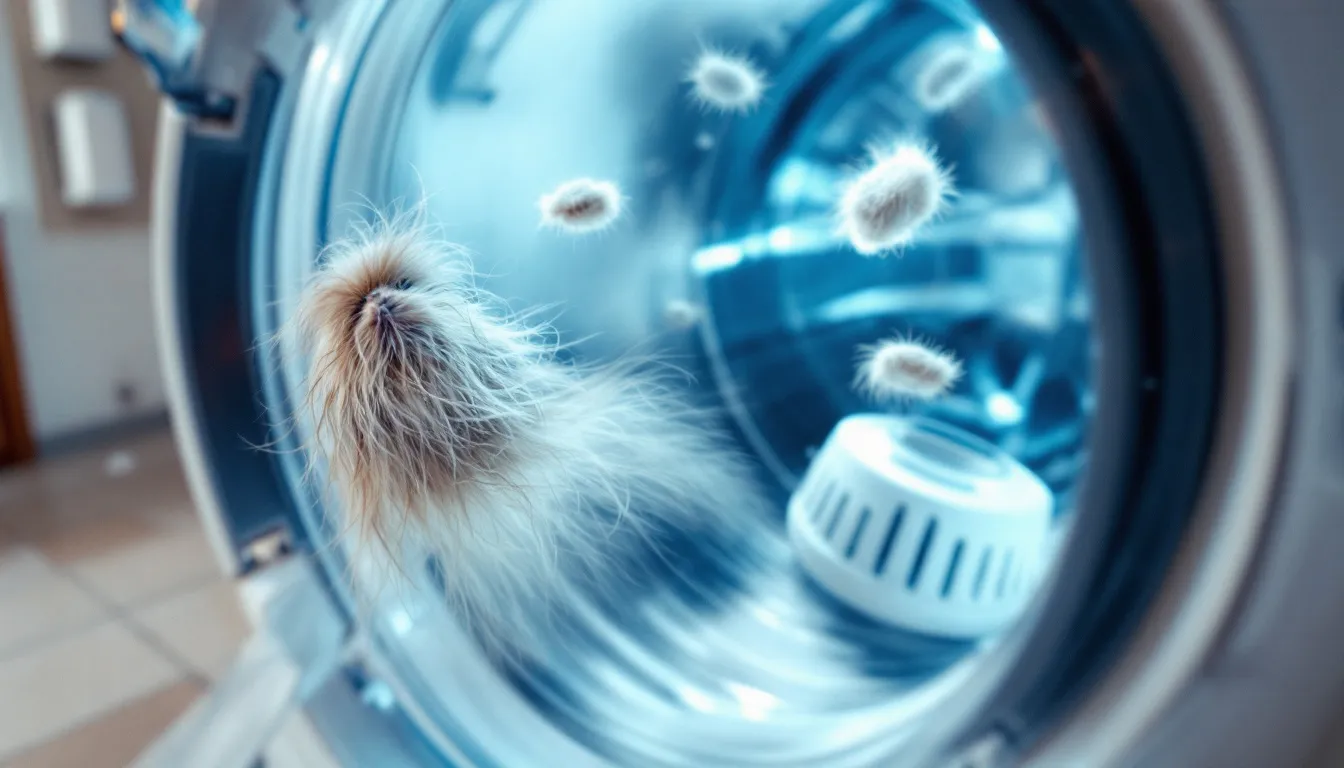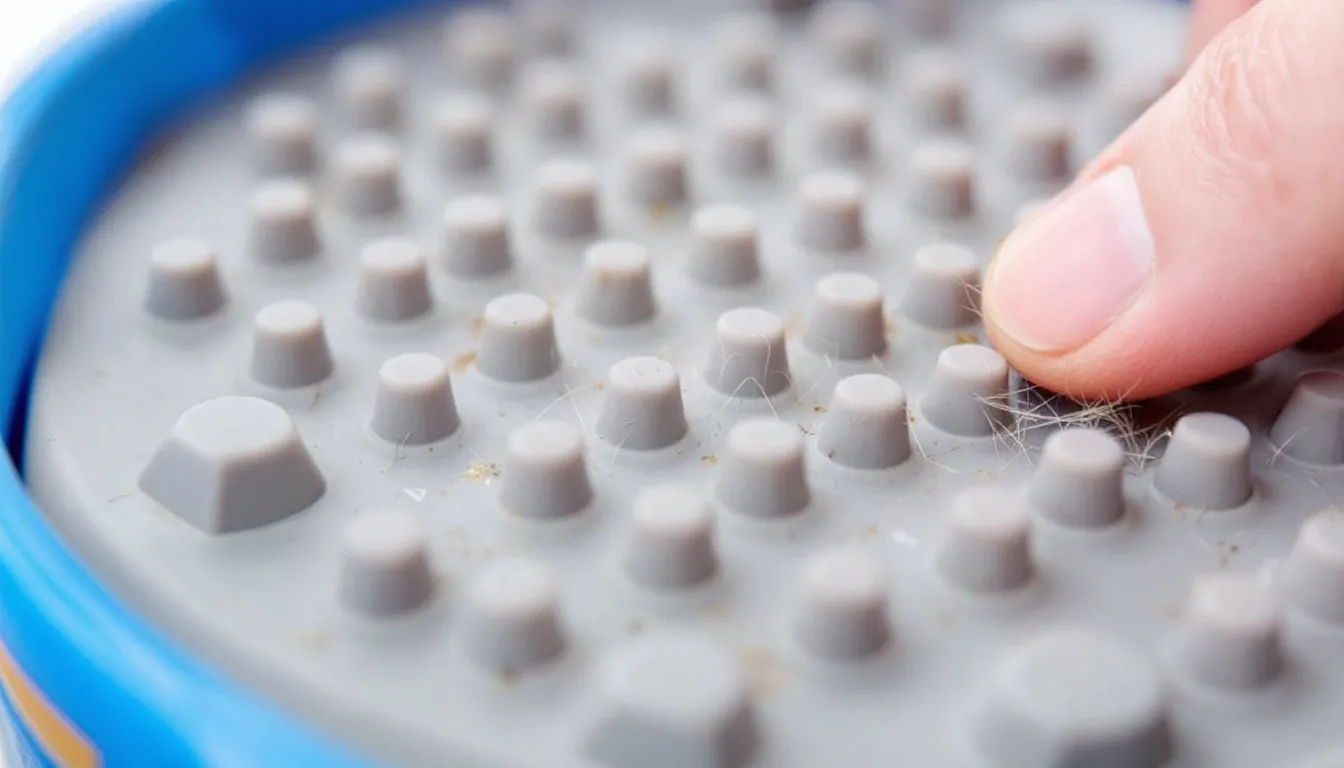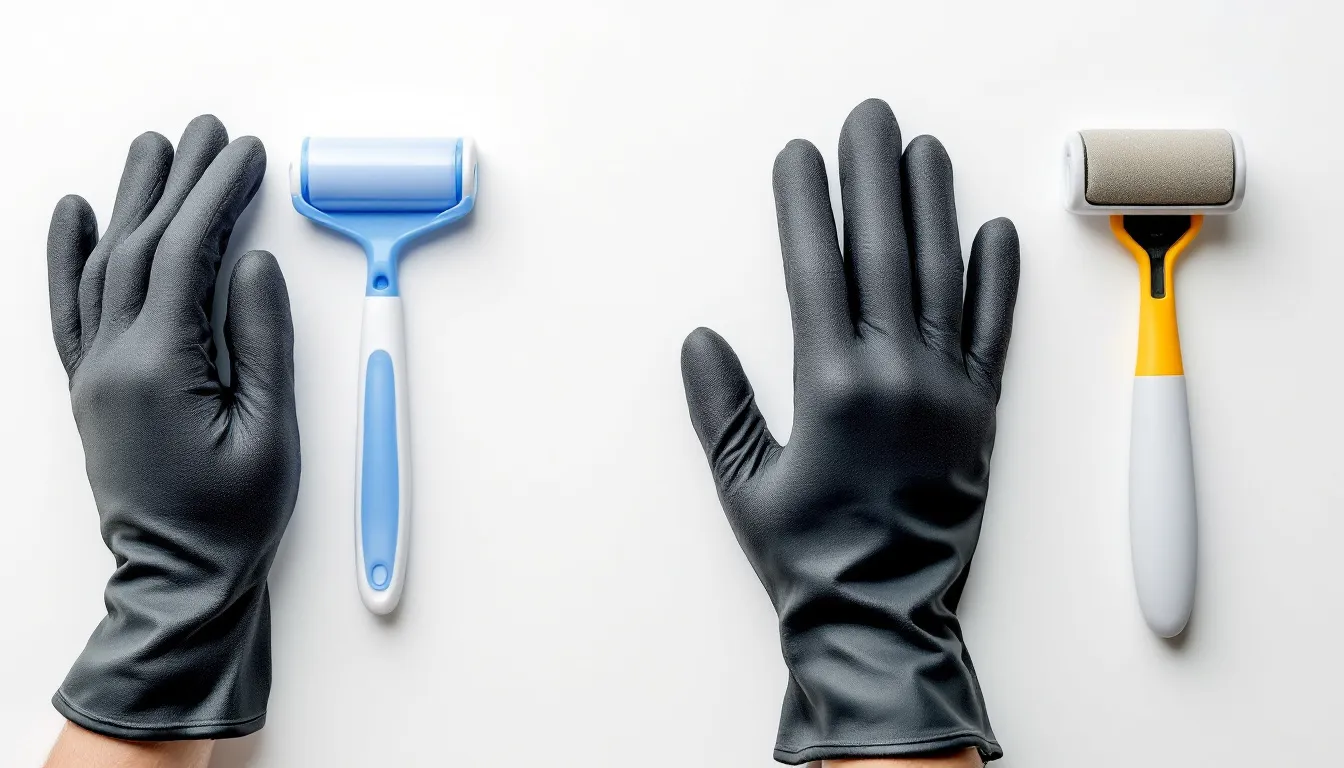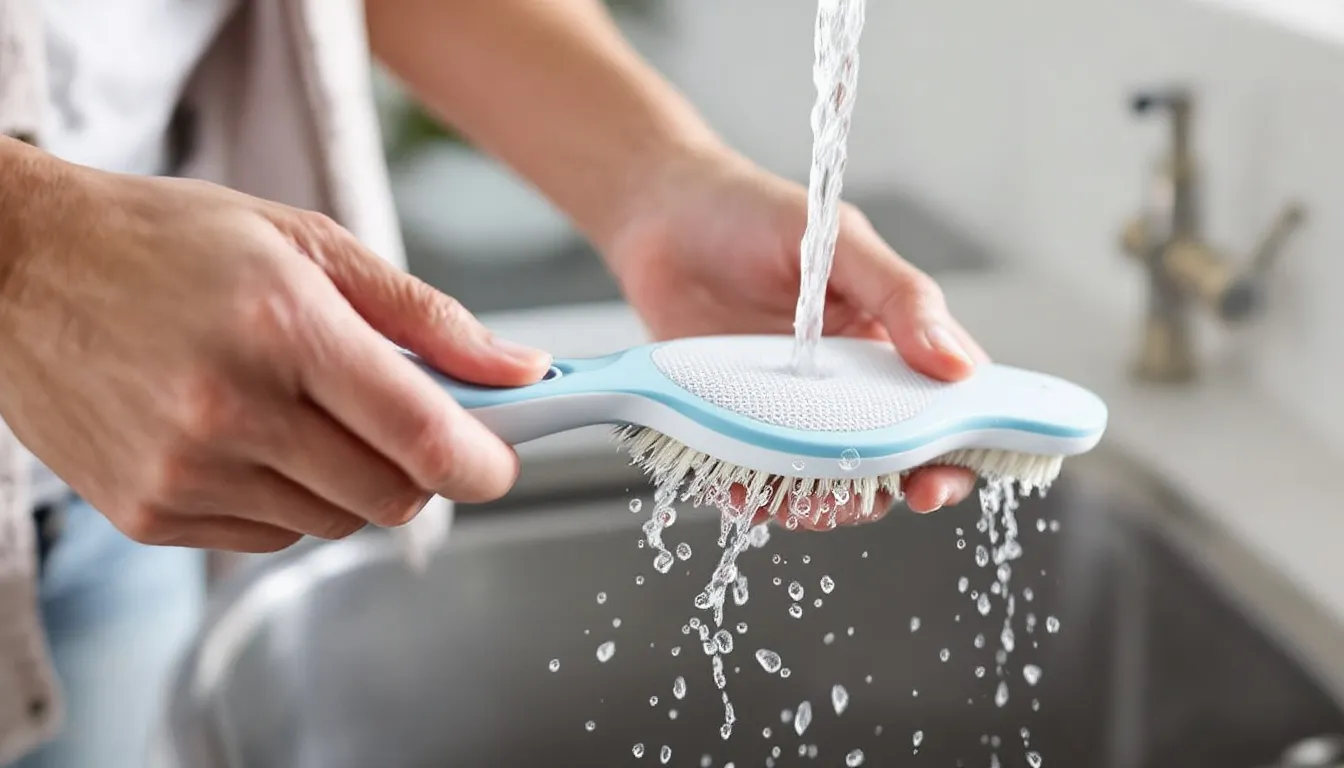Every pet parent faces the same frustrating scenario: pulling clothes from the washer only to find them covered in even more pet hair than before. Despite your best efforts with lint rollers and rubber gloves, that stubborn dog hair and cat fur seems determined to cling to every piece of fabric in your home. Enter the pet hair catcher—a revolutionary laundry accessory that’s changing how pet parents tackle the never-ending battle against fur. Some products are also marketed as a pet hair remover, designed for quick and effortless removal of pet hair from various surfaces like furniture, clothing, and laundry.
Unlike traditional methods that require manual effort before and after washing, pet hair catchers work automatically during your regular wash and dry cycles. These ingenious devices trap pet fur, lint, and other debris—including hair from both human and pet sources—while your clothes tumble, delivering cleaner results without extra work on your part. Whether you’re dealing with heavy shedding season or everyday pet hair buildup, understanding how these catchers work can transform your laundry routine from a fur-covered nightmare into a smooth, efficient process.

Introduction to Pet Hair Problems
For pet parents, dealing with pet hair is a daily reality that can quickly become overwhelming. Whether it’s cat hair clinging to your favorite black sweater or dog hair coating your furniture and car seats, fur has a way of finding its way onto every surface in your home. Not only does this make clothes and upholstery look untidy, but lingering pet hair can also contribute to allergies and respiratory discomfort, especially for sensitive family members.
The challenge of keeping your environment fur free goes beyond simple aesthetics. Pet hair can embed itself in fabrics, making it tough to remove with a quick swipe of a lint roller or a pass of the vacuum. As a result, many pet parents find themselves constantly battling lint, fur, and other debris on their clothes, bedding, and even in the laundry itself. This ongoing struggle highlights the need for effective pet hair removers and smart cleaning strategies.
In this guide, we’ll explore the root causes of pet hair problems and introduce a range of solutions—from classic lint rollers to innovative laundry tools—so you can enjoy a cleaner, healthier home and spend less time worrying about fur.
Understanding Pet Fur
Pet fur, whether it’s the fine cat fur that floats through the air or the thicker dog fur that sheds in clumps, is a natural part of life with pets. Shedding is influenced by breed, age, health, and even the changing seasons, meaning some pets will leave more hair around the house than others. While regular grooming and brushing can help reduce the amount of loose pet hair, it’s nearly impossible to eliminate shedding entirely.
Once shed, pet hair tends to stick to clothing, upholstery, and bedding, often working its way deep into fabric fibers. Traditional tools like sticky tape and lint rollers can help with surface removal, but they’re not always efficient for larger areas or embedded fur. Plus, constantly replacing disposable lint rollers isn’t the most sustainable or cost-effective approach.
To truly tackle pet hair, pet parents need efficient, non toxic solutions that can handle everything from daily clothing to heavy-duty laundry loads. In the following sections, we’ll look at innovative tools and techniques that go beyond the basics, helping you keep your home and wardrobe fur free.
What is a Pet Hair Catcher?
A pet hair catcher is a specialized laundry accessory designed to remove pet fur during washing and drying cycles automatically. These innovative devices use tacky, flexible materials that attract and hold onto pet hair, lint, and dander while your clothes agitate in the washing machine or tumble in the dryer. The key difference from traditional lint rollers is that pet hair catchers work hands-free during the regular laundry process, requiring no additional manual effort from pet parents.
These catchers excel at removing both dog hair and cat hair from all types of fabrics, including delicate materials that might be damaged by aggressive brushing. The specialized materials used in quality pet hair catchers create a gentle yet effective pulling action that lifts embedded fur from fabric fibers without causing damage to your clothing, blankets, or bedding. For best results, use short, rapid push-pull motions to help dislodge stubborn hair from surfaces.
What sets pet hair catchers apart from conventional lint removal methods is their ability to work continuously throughout the entire wash cycle. As clothes move and agitate, the catcher’s surface grabs loose hair and prevents it from redistributing onto other garments. This automated approach means you can finally skip the pre-wash ritual of manually removing fur from every piece of clothing.
Most pet hair catchers are designed to be completely non toxic and hypoallergenic, making them safe for households with sensitive skin or allergies. The materials won’t break down or leave residue on your clothing, ensuring your laundry comes out clean and fresh without any chemical concerns. Some advanced pet hair catchers also feature a transparent window, allowing you to easily see when the device needs to be emptied for optimal performance.
Types of Pet Hair Catchers
Pet hair catchers come in several distinct varieties, each engineered for specific laundry applications and effectiveness levels. Understanding these differences helps pet parents choose the right solution for their household’s unique needs.
In-wash hair catchers are designed specifically for washing machines and work by floating freely in the water during the wash cycle. These catchers use the natural agitation of the washing machine to loosen pet hair from fabric fibers. The most common design resembles a sticky ball or disc that moves around the drum, collecting fur as it encounters clothing, towels, and other fabrics.
Dryer hair catchers operate during the drying process, using heat and tumbling action to further loosen pet hair that survived the wash cycle. These often feature different material compositions optimized for the dry environment of the dryer, where static cling plays a larger role in hair removal effectiveness.
Dual-purpose catchers represent the most versatile option, functioning effectively in both wash and dry cycles. These innovative designs typically use advanced synthetic materials that maintain their tacky properties whether wet or dry, providing comprehensive fur removal throughout the entire laundry process.
Material differences significantly impact performance and durability. Silicone-based catchers offer excellent flexibility and maintain their grabbing power through hundreds of wash cycles. Rubber variants provide strong static properties that excel at pulling hair away from synthetic fabrics. Proprietary synthetic materials, like those used in premium brands, often combine multiple beneficial properties for superior pet hair removal across various fabric types.
The choice between these types often depends on your specific situation—households with heavy shedding pets might benefit from dual-purpose catchers, while those dealing with moderate hair levels might find in-wash catchers sufficient for their needs.
How Pet Hair Catchers Work
The science behind pet hair catchers involves a combination of material properties and physical principles that work together during the laundry process. The tacky, flexible materials used in quality catchers create an attraction force that’s stronger than the bond between pet fur and fabric fibers, effectively pulling hair away during agitation.
During wash cycles, the mechanical action helps dislodge embedded fur that’s been worked deep into fabric weaves. As the pet hair catcher moves through the water with your clothes, its surface area contacts multiple garments simultaneously, creating numerous opportunities to grab loose hair. The agitation also helps loosen pet hair that might be too deeply embedded for static removal alone. Importantly, the pet hair catcher washes pet hair, fur, and dander away during the laundry process, ensuring cleaner clothes and bedding.
Static properties play a crucial role, especially in dryer applications. As fabrics tumble and generate electrical charges, pet hair catchers with the right material composition attract these charged particles more effectively than the clothing itself. This static differential pulls hair away from fabrics and onto the catcher’s surface, where it remains trapped.
The self-cleaning mechanism is perhaps the most ingenious aspect of modern pet hair catchers. As the device continues to move and flex during the cycle, collected hair gradually works its way off the catcher’s surface. In washing machines, this hair flows into the lint screen or drain system. In dryers, the hair typically falls into the lint trap along with other debris, making cleanup simple and automatic.
Advanced catchers also utilize micro-textures on their surfaces that create tiny pockets where hair can be temporarily held before being released into the appropriate collection system. This prevents the catcher from becoming oversaturated and losing effectiveness mid-cycle.

Top Benefits of Using Pet Hair Catchers
The advantages of incorporating pet hair catchers into your laundry routine extend far beyond simple convenience, offering pet parents significant improvements in efficiency, cost savings, and environmental impact.
Hands-free pet hair removal represents the primary benefit that attracts most pet parents to these devices. Unlike lint rollers that require you to manually roll every surface of every garment, pet hair catchers work automatically while you focus on other tasks. Pet hair catchers are also effective at removing hair from a variety of surfaces, including beds and pet beds, helping maintain cleanliness in sleeping areas. This automation is particularly valuable for households with multiple pets or during heavy shedding seasons when manual removal becomes overwhelming.
Reusable and eco-friendly design makes pet hair catchers a sustainable alternative to disposable lint rollers. While sticky tape and disposable rollers create ongoing waste, quality catchers can last for hundreds of wash cycles. This reusability significantly reduces environmental impact while providing consistent performance over time.
Non toxic and hypoallergenic materials ensure safety for all family members, including those with sensitive skin or allergies. Unlike some fabric softeners or chemical treatments, pet hair catchers use purely mechanical action to remove fur, eliminating concerns about residue or chemical sensitivity.
Cost-effective solution becomes apparent when comparing long-term expenses. While lint rollers require constant replacement, especially in multi-pet households, a single pet hair catcher can handle years of regular use. Pet parents often find the investment pays for itself within months through eliminated lint roller purchases.
Reduced maintenance of appliances provides an often-overlooked benefit. By capturing hair before it reaches your washing machine’s drain system or dryer’s lint filter, catchers reduce the frequency of deep cleaning required for optimal appliance performance. This preventive approach can extend appliance life and reduce repair costs.
The effectiveness in reducing lint buildup in dryer vents also contributes to improved energy efficiency and reduced fire risk, making pet hair catchers a smart safety investment for any household with pets.
How to Use Pet Hair Catchers Effectively
Proper usage techniques can dramatically improve your pet hair catcher’s effectiveness, ensuring maximum fur removal with every load. Following these step-by-step instructions and best practices will help you achieve consistently clean, fur-free results.
Adding catchers to your washer requires careful timing and placement. Before loading clothes, add the recommended number of catchers to the empty drum. Most manufacturers suggest one catcher per small load, two for medium loads, and up to three for large or heavily fur-covered loads. The catchers need space to move freely, so avoid overloading your washing machine beyond 75% capacity.
Optimal wash cycle settings enhance catcher performance significantly. Use warm water when fabric care labels allow, as the higher temperature helps loosen pet hair more effectively than cold water. Select a longer wash cycle to provide maximum agitation time for the catchers to work. An extra rinse cycle ensures complete hair removal and prevents redistribution during the final spin. Items are thoroughly washed to remove pet hair and fur from fabrics.
Avoiding fabric softeners and dryer sheets is crucial for maintaining catcher effectiveness. These products can coat the catcher’s surface, reducing its ability to grab pet hair. Similarly, liquid fabric softener can create a slippery film that prevents proper hair adhesion. If you prefer soft fabrics, consider using white vinegar in the rinse cycle as a natural fabric softener alternative.
Pre-treating heavily fur-covered items maximizes results for challenging loads. Give bedding, furniture covers, and heavily soiled clothing a quick shake outdoors before washing. For best results, wipe fabric surfaces with a damp microfiber cloth in straight lines to remove loose pet hair before washing. For extremely furry items like pet blankets, run them through a quick pre-wash cycle with just the catchers to remove the majority of loose hair before adding other clothes.
Dryer usage techniques require different considerations. If using dual-purpose catchers, transfer them directly from washer to dryer with your clothes. For dryer-specific catchers, add them to damp clothes at the beginning of the dry cycle. Avoid using high heat settings, which can reduce catcher effectiveness and potentially damage the specialized materials.
Regular monitoring during the first few uses helps you determine the optimal number of catchers and cycle settings for your specific pet hair challenges and machine characteristics.
Non-Toxic Removal Options
If you’re looking to keep your home clean without relying on harsh chemicals or disposable products, non-toxic pet hair removal options are a smart choice. Reusable pet hair removers, such as lint rollers that don’t use sticky tape, offer an eco-friendly way to tackle fur on clothing and furniture. These tools often use electrostatic charges or rubber surfaces to attract and trap pet hair, making them both effective and gentle on fabrics.
Rubber-based tools, like rubber gloves or specialized brushes, can be used with a quick swipe to loosen pet hair from upholstery, car seats, and even clothing. For laundry, adding a splash of white vinegar to the wash can help loosen pet hair from fabrics and reduce odors, all without introducing chemicals into your home. Regularly cleaning your washing machine and dryers with natural products also helps prevent lint and fur buildup, keeping your appliances running efficiently.
By choosing non-toxic, reusable pet hair removal methods, you can maintain a fur free environment while minimizing waste and protecting your family and pets from unnecessary chemicals.
Laundry Additives for Hair Removal
Laundry additives are a powerful ally in the fight against stubborn pet hair. Products like FurZapper and FurBall are designed to be tossed directly into the wash cycle, where they work to loosen and collect pet hair from clothing, towels, and bedding. These additives use static electricity to attract hair, making it easier for the washing machine and dryer to remove fur during each cycle.
In addition to specialized products, common laundry additives like fabric softeners and dryer sheets can help reduce static cling, which in turn makes pet hair less likely to stick to fabrics. However, it’s important to choose non-toxic, gentle options to avoid irritating sensitive skin or damaging delicate materials. Look for fragrance-free or hypoallergenic fabric softeners and dryer sheets to keep your laundry routine safe for both pets and people.
By incorporating the right laundry additives into your wash and dry cycles, you can significantly reduce the amount of pet hair left behind on your clothing and fabrics, making each load come out cleaner and more comfortable to wear.
Sustainable Removal Practices
For pet parents who want to keep their homes fur free while also caring for the environment, sustainable pet hair removal practices are key. Opting for reusable tools like lint rollers with washable surfaces or rubber gloves means you can tackle pet hair again and again without creating extra waste. These tools are easy to clean—just rinse them off after use and they’re ready for the next round of pet hair removal.
Natural laundry additives, such as white vinegar or baking soda, offer a biodegradable, non-toxic way to help loosen pet hair in the wash. By skipping disposable dryer sheets and sticky tape in favor of reusable alternatives, you’ll reduce your household waste and your carbon footprint. Regularly washing and maintaining your pet hair removal tools ensures they stay effective and last longer, further supporting a sustainable lifestyle.
By making these small changes, pet parents can enjoy a cleaner, fur free home while promoting a healthier environment for their pets and families. Sustainable practices not only benefit the planet—they also save you money and time in the long run.
Pet Hair Catcher vs Other Removal Methods
Understanding how pet hair catchers compare to traditional removal methods helps pet parents make informed decisions about their fur-fighting strategy. Each approach offers distinct advantages and limitations depending on your specific needs and household situation.
Lint rollers vs. pet hair catchers present the most common comparison. Lint rollers excel at targeted spot cleaning and pre-wash fur removal but require constant replacement and manual effort. A single lint roller typically handles 2-3 uses before becoming ineffective, while pet hair catchers provide consistent performance for hundreds of cycles. The time investment differs dramatically—lint rolling a full load of laundry can take 10-15 minutes, while catchers work automatically during regular wash cycles.
Rubber gloves effectiveness offers a middle-ground solution that many pet parents use for furniture cleaning. Dampening rubber gloves and wiping surfaces creates static that attracts pet hair effectively. However, this method becomes impractical for clothing and requires significant manual effort for large areas. The rubber glove technique works well for car seats and upholstery but cannot match the comprehensive coverage provided by catchers during laundry cycles.
Microfiber cloth approaches utilizing damp microfiber cloths can remove pet hair through static attraction and mechanical grabbing. While effective for furniture and carpets, this method requires frequent cloth rinsing and doesn’t address hair embedded in clothing fibers. The labor-intensive nature makes it unsuitable for regular laundry processing.
Cost analysis over time reveals significant differences between methods. Disposable lint rollers cost approximately $3-5 monthly for moderate use, totaling $36-60 annually. Quality pet hair catchers range from $10-25 for a set that lasts 2-3 years, making them substantially more economical for regular use.
Effectiveness comparison shows that pet hair catchers excel at automated, bulk removal during laundry cycles, while traditional methods work better for targeted cleaning and pre-treatment. Many pet parents find the most effective approach combines methods: using catchers for regular laundry while keeping lint rollers for quick touch-ups and spot cleaning.
The convenience factor heavily favors catchers for busy households, as they eliminate the need for pre-wash fur removal routines that can add 15-20 minutes to laundry preparation time.

Popular Pet Hair Catcher Brands and Features
The pet hair removal market features several standout brands, each offering unique technologies and design approaches that address different aspects of the fur-fighting challenge. Understanding these options helps pet parents select products that match their specific needs and expectations.
FurZapper represents one of the most recognizable names in the category, gaining national attention after appearing on Shark Tank. Their design utilizes a proprietary tacky material that maintains its grabbing power through extended use. FurZapper products work in both wash and dry cycles, featuring a unique texture pattern that maximizes surface contact with fabrics. The company emphasizes durability, with products designed to last through hundreds of cycles without losing effectiveness.
FurBall 2.0 introduces RSX material technology, representing an advancement in synthetic material engineering specifically for pet hair removal. This material demonstrates superior static properties while maintaining flexibility across temperature ranges. Beyond hair removal, FurBall 2.0 products claim additional benefits including wrinkle reduction during drying cycles, making them appealing for pet parents seeking multiple laundry improvements.
Key features to evaluate when comparing brands include material durability, effectiveness across different fabric types, and compatibility with various machine types. Premium catchers often feature multi-layer construction that provides both immediate hair grabbing and long-term material integrity. Some brands offer specialized versions for high-efficiency machines, which require different material properties due to lower water levels and modified agitation patterns.
Price ranges and value considerations vary significantly across the market. Basic catchers start around $8-12 for a pair, while premium options with advanced materials can reach $20-30. Mid-range products typically offer the best balance of effectiveness and longevity for most households. When evaluating value, consider the expected lifespan—a $15 catcher that lasts two years provides better value than a $8 option that needs replacement every six months.
Specialized features distinguish premium products from basic alternatives. Some catchers include antimicrobial treatments to prevent odor development, while others feature enhanced grip patterns for specific fabric types. Advanced designs might incorporate multiple material zones optimized for different hair types—fine cat fur versus coarse dog hair require different removal approaches.
User reviews consistently highlight that effectiveness varies significantly based on pet type, hair length, and fabric composition, making it important to choose catchers specifically designed for your household’s characteristics.
Maintenance and Care Tips
Proper maintenance ensures your pet hair catcher maintains peak performance throughout its lifespan while providing consistent fur removal results. Following these care guidelines will maximize your investment and keep your laundry routine running smoothly.
Cleaning frequency recommendations depend on usage intensity and household pet population. For single-pet households with moderate shedding, clean catchers every 10-15 uses. Multi-pet homes or heavy shedding periods may require cleaning every 5-8 cycles. Signs that indicate immediate cleaning include visible hair buildup on the catcher surface, reduced effectiveness during recent cycles, or any odor development.
Simple cleaning methods restore catcher performance quickly and easily. Remove the catcher from your washer or dryer and rinse under warm running water while gently rubbing the surface with your fingers. For stubborn hair or lint buildup, use a soft brush or old toothbrush to gently work debris from textured surfaces. Mild soap can help remove any fabric softener residue that might have accumulated despite best efforts to avoid these products.
Deep cleaning techniques for heavily soiled catchers involve soaking in warm water with a small amount of dish soap for 15-20 minutes before gentle scrubbing. For stubborn pet hair or soap scum inside the washing machine, dip a sponge into the cleaning solution and use it to scrub away buildup in hard-to-reach areas. Avoid harsh chemicals or abrasive cleaning tools that could damage the specialized surface materials. After cleaning, allow catchers to air dry completely before returning them to service—trapped moisture can reduce effectiveness and potentially promote bacterial growth.
Replacement indicators help you recognize when catchers have reached the end of their useful life. Reduced stickiness that doesn’t improve with cleaning, visible cracks or tears in the material, or persistent odors despite thorough cleaning all indicate replacement time. Quality catchers typically last 6-12 months with regular use, though premium materials may extend this timeframe significantly.
Storage recommendations preserve catcher effectiveness between uses. Store clean, dry catchers in a cool, dry location away from direct sunlight and heat sources. Avoid storing catchers in contact with fabric softener, dryer sheets, or other products that could coat their surfaces. Some pet parents keep catchers in a dedicated container to prevent accidental contamination.
Troubleshooting common issues addresses frequent concerns. If catchers seem less effective, first ensure you’re not overloading your machine and verify that fabric softeners aren’t being used. Reduced grabbing power often indicates cleaning is needed or that the catcher has accumulated residue from laundry products.

Best Practices for Maximum Hair Removal
Achieving optimal results with pet hair catchers requires understanding how to integrate them effectively into a comprehensive fur management strategy. These advanced techniques help pet parents maximize removal efficiency while maintaining convenience.
Pre-wash preparation techniques significantly enhance catcher effectiveness. Before loading clothes into the washer, give items a vigorous shake outdoors to remove loose surface hair. For heavily furred items like pet bedding or furniture covers, a quick brush with a lint brush or rubber glove removes the majority of loose fur before washing. This pre-treatment prevents overwhelming the catchers and allows them to focus on embedded hair that requires mechanical action to remove.
Optimal washing machine settings create ideal conditions for pet hair removal. Use the longest wash cycle available for your fabric types, providing maximum agitation time for catchers to work effectively. Warm water temperatures help loosen pet hair more effectively than cold water, though always check fabric care labels first. Load machines to no more than 75% capacity—catchers need space to move freely and contact all garments during the cycle.
Extra rinse cycle benefits ensure complete hair removal and prevent redistribution during the final spin. The additional water flow helps flush loosened hair toward the lint screen and prevents it from reattaching to clothing. This extra step is particularly valuable for loads containing synthetic fabrics, which tend to attract and hold pet hair more stubbornly than natural fibers.
Regular pet grooming integration provides the most effective long-term solution to excessive shedding. Brushing cats and dogs daily during shedding season significantly reduces the amount of loose fur that ends up on clothing and furniture. This proactive approach makes pet hair catchers more effective by reducing the total volume they need to handle per load.
Enhanced appliance maintenance supports optimal catcher performance. Clean your washing machine’s lint screen more frequently when using catchers, as they will capture more hair that flows into drainage systems. Similarly, check and clean your dryer’s lint filter after every load rather than every few loads. Washing machines and dryers, including their filters and vents, should be regularly cleaned to prevent pet hair buildup, maintain optimal performance, and reduce fire hazards. This increased maintenance prevents hair buildup from reducing airflow and drying efficiency.
Strategic load grouping maximizes effectiveness by processing similar items together. Wash heavily furred items like pet blankets and bedding separately from regular clothing, allowing catchers to focus on high-hair-volume loads. This approach prevents cross-contamination and ensures your regular clothes come out truly fur free.
Room environment considerations impact overall hair management success. Using air purifiers in bedrooms and living areas reduces airborne pet hair that eventually settles on clothing and furniture. Regular vacuuming of carpets and upholstery with pet-specific attachments prevents hair accumulation that transfers to clothing through contact.
Seasonal adjustments help pet parents adapt their approach during peak shedding periods. Spring and fall typically bring increased shedding for most pets, requiring more frequent grooming and potentially additional catchers per load. During these periods, consider using the maximum recommended number of catchers and running extra rinse cycles for optimal results.
By combining these best practices with quality pet hair catchers, pet parents can finally achieve consistently clean, fur-free laundry without the time-consuming manual removal that traditional methods require. The key lies in treating hair removal as a systematic process rather than relying on any single solution, no matter how effective.

